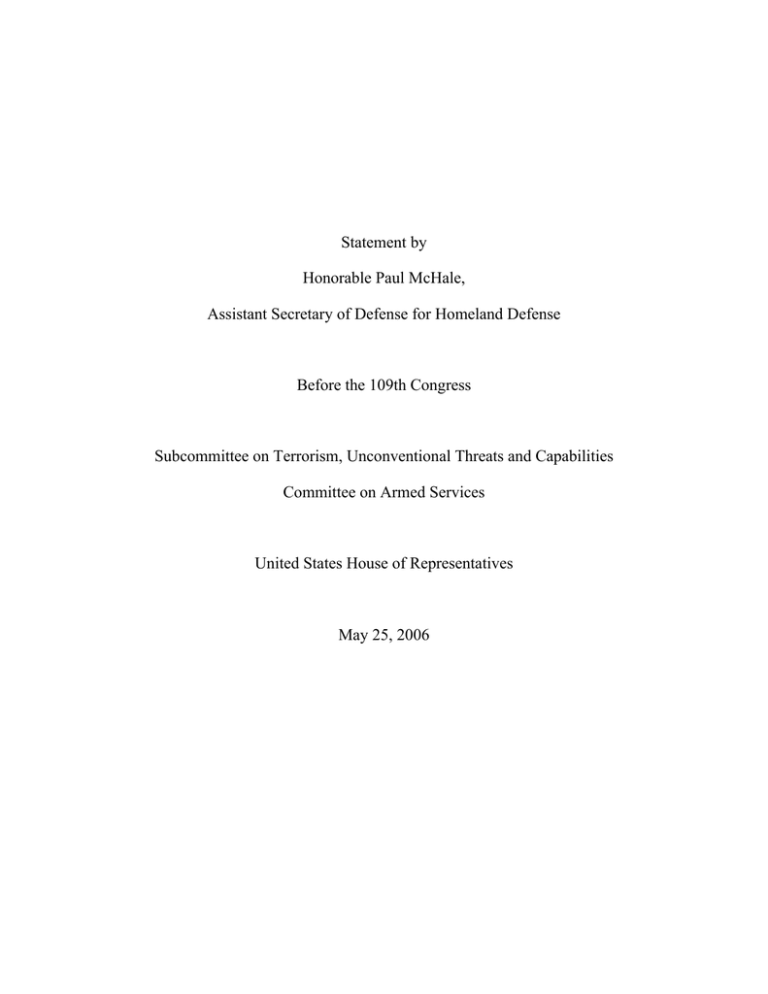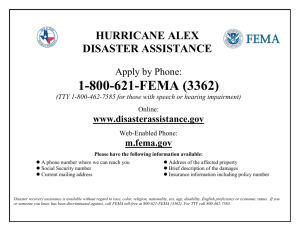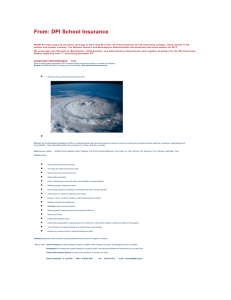Statement by Honorable Paul McHale, Assistant Secretary of Defense for Homeland Defense
advertisement

Statement by Honorable Paul McHale, Assistant Secretary of Defense for Homeland Defense Before the 109th Congress Subcommittee on Terrorism, Unconventional Threats and Capabilities Committee on Armed Services United States House of Representatives May 25, 2006 INTRODUCTION Chairman Saxton, Ranking Member Meehan, distinguished members of this Subcommittee: thank you for inviting me here to address the progress we have made in preparing for the 2006 hurricane season. Hurricane Katrina was one of the worst natural disasters in U.S. history – in terms of persons displaced, businesses disrupted, commerce affected, and in projected aggregate economic losses. In response to the massive devastation caused by the storm, the Department of Defense’s (DoD’s) deployment of military resources in support of civil authorities after Hurricane Katrina exceeded, in speed and size, any other domestic disaster relief mission in the history of the United States. The ability of our military forces -- Active Duty, Reserves, and the National Guard -- to respond quickly and effectively to an event of this magnitude is a testament to their readiness, agility, and professionalism. As President Bush said on April 27, 2006, in New Orleans, Louisiana, “One of the things that we're working on is to make sure that we've learned the lessons from Katrina -- we've learned lessons at the Federal level and State level and the local level. And we're now working closely together in preparation of the upcoming hurricane season.” DOD ACTIONS TO PREPARE FOR THE 2006 HURRICANE SEASON Mindful of the lessons learned during Hurricane Katrina and with an extraordinary sense of urgency, DoD has taken deliberate action to prepare for the 2006 hurricane season. 1 Interagency Coordination By June 1, 2006, DoD will have assigned a Defense Coordinating Officer (DCO) to each of the ten Department of Homeland Security (DHS)/Federal Emergency Management Agency (FEMA) regional office. DoD is giving priority to hurricane-prone Regions IV (Alabama, Florida, Georgia, Kentucky, Mississippi, North Carolina, South Carolina, and Tennessee) and VI (Arkansas, Louisiana, New Mexico, Oklahoma, and Texas); both will have a fully staffed DCO and a five-member Defense Coordinating Element (DCE) complement by June 1, 2006. By August 2006, DoD will have a fully-staffed DCE complement in all ten of the FEMA regional offices. In the interim, from June to September 2006, any temporary vacancies in the DCEs will be filled by Emergency Preparedness Liaison Officers (EPLOs), who are senior military Reserve officers trained in emergency response operations. The DCO and DCE will have the capability to deploy in support of an interagency Joint Field Office (JFO), which is a facility that integrates Federal, State, local, tribal and private sector incident management entities. In coordination with DHS, FEMA, and the Department of Transportation (DOT), DoD has developed 18 pre-scripted Requests for Assistance (RFAs) to expedite the provision of DoD support to civil authorities during a disaster response. These 18 pre-scripted RFAs address DoD support for: • Transportation (helicopters and fixed-wing aircraft); • Communications; • Public works and engineering (debris removal); • Emergency management (DCO/DCE and damage assessment aircraft); 2 • Mass care, housing, and human services (prepare temporary housing and food distribution to points of departure); • Resource support (installations, mobilization centers, and ground fuel distribution); and, • Public health and medical services (helicopter medevac and temporary medical facilities). On March 31, 2006, FEMA and the Defense Logistics Agency (DLA) signed an Inter-Agency Agreement (IAA), stating that DLA will provide logistics support to FEMA. Additionally, DLA will detail a Liaison Officer to FEMA during disaster response operations. DLA has also been working with FEMA to prepare and plan for logistical support during all phases of an event, FEMA provided $70 million to DLA to procure, store, rotate, and provide supplies, including Meals-Ready-to-Eat (MREs), commercial meal alternatives, health and comfort kits, tents, generators, fuel, medical supplies, construction items and other equipment. In addition, DoD’s depot infrastructure is prepared for the supply, storage, and distribution of Federal assets. In addition, DoD has been participating in weekly interagency meetings with DHS, DOT, Department of Justice, Department of Health and Human Services, and other Federal departments and agencies to coordinate Federal planning and preparations for the 2006 hurricane season. Planning We have undertaken significant planning initiatives to prepare for the 2006 hurricane season. For instance, the Secretary of Defense is currently reviewing 3 U.S. Northern Command’s (USNORTHCOM’s) revised Contingency Plan (CONPLAN) 2501 for Defense Support of Civil Authorities (DSCA). This CONPLAN will provide guiding principles for DoD operations and the technical/operational architecture for DSCA. USNORTHCOM is also developing a reconnaissance annex to this CONPLAN, which will provide the mechanisms to request, approve, and coordinate DoD damage assessment operations in support of civil authorities. USNORTHCOM tested the annex’s concepts during the ARDENT SENTRY exercise from May 8-18, 2006, and expects to complete this annex, including incorporating any lessons learned during ARDENT SENTRY, by September 2006. DoD has also participated in numerous interagency and intergovernmental planning efforts. For example: • Beginning in February 2006, USNORTHCOM has participated in DHS’ effort to review emergency response plans in all 50 States, the Commonwealth of Puerto Rico, Guam, and the U.S. Virgin Islands, and the District of Columbia; • At my request, USNORTHCOM deployed planners to conduct comprehensive vulnerability assessment in the Gulf Coast states with an emphasis on Louisiana. The assessment effort was integrated into an interagency effort led by FEMA. The areas assessed were evacuation, search and rescue, and communications interoperability. DoD is working to identify potential assets that may be required to fill gaps in capabilities; • On March 1, 2006, USNORTHCOM hosted a catastrophic incident Rapid Response Operational Planning Conference in Colorado Springs, Colorado, which brought together Federal disaster response participants including 4 DHS the Federal Bureau of Investigation, and Urban Search and Rescue teams; • On March 20, 2006, USNORTHCOM hosted a Hurricane Planning Conference with State Adjutants General; • From April 4-6, 2006, USNORTHCOM and Army North (ARNORTH) cohosted a Federal Coordinating Office (FCO) / Defense Coordinating Officer (DCO) Conference in San Antonio, Texas; the conference focused on orientation and planning for 2006 severe weather season; • On April 6, 2006, DoD provided planners to DHS (3 USNORTHCOM operational planners and 1 U.S. Transportation Command transportation planner) to assist with the development of response plans for the 2006 hurricane season. The resulting plans will focus on the provision of logistics to an area impacted by a major or catastrophic hurricane; • On April 21, 2006, the Secretary of Defense approved the increase the number of planners at DHS to 12 personnel. These additional planners arrived on April 24, 2006. During April 14-28, 2006, DoD personnel accompanied the Secretary of Homeland Security on a tour of the Gulf Coast States to discuss and assess 2006 hurricane preparations; • From April 10-11, 2006, the National Geospatial Intelligence Agency (NGA) hosted the DHS Damage Assessment Conference to discuss available assets for damage assessment for the 2006 hurricane season; • From April 10-14, 2006, DoD participated in the National Hurricane Conference in Orlando, Florida; • The Joint Staff, DLA, and USNORTHCOM participated in the interagency Domestic Disaster Response Logistics Working Group that is synchronizing logistics planning for the 2006 hurricane season. In addition, from April 12-13, 2006, the DoD Logistics Working Group for Domestic 5 Disaster Response met with FEMA planners to begin the development of a logistics concept of operations in advance of the 2006 hurricane season; • From April 20-21, 2006, DoD participated in the FEMA Pre-Hurricane Conference to conduct advance planning for the 2006 severe weather season; • DoD has published the DSCA Standing Execute Order (EXORD), that authorizes the commanders of USNORTHCOM, U.S. Pacific Command, and U.S. Southern Command to prepare DoD assets in order to be ready to deploy in support of civil authorities in response to natural disasters. Assets covered by this EXORD include: o Senior officers for command, control and coordination; o Identification of DoD installations as staging sites; o Helicopters for search and rescue and transportation for damage assessment; o Aircraft for situational awareness and to support the movement of special needs patients; o Communications teams to facilitate communications interoperability; o Liaison officer communications packages; o A joint airborne command center/command post; and, o Logistical specialists for the establishment of food, water, and medical supply distribution points. • Finally, in April 2006, DoD, in coordination with the Department of Health and Human Services, developed the DoD sections of a Medical Services 6 Concept Plan for Hurricane Season 2006, and the Hurricane Response Action Steps document. These documents provide steps for coordinating and/or managing the Federal public health and medical assets required prior to, and in the aftermath of, a hurricane or tropical storm making landfall in the United States, the Commonwealth of Puerto Rico, Guam, or the Virgin Islands. Per these documents, potential DoD support could include: o Helicopters and aircraft for evacuation of special needs patients; o Ground ambulance/ambulance bus transportation with accompanying medical attendants to move casualties; o Medical regulating teams to assist in coordinating and moving patients; o Surgical support augmentation, including general surgeons, anesthesiologists, operating room nurses, and surgical support personnel; o Medical support augmentation, including internal medicine medical officers, medical/surgical nurses, corpsmen/medics; and, o Victim identification teams to support the recovery and identification of remains. Emergency Response Exercises DoD has executed or participated in numerous exercises to prepare for this year’s hurricane season. For instance: • DoD has participated in several Catastrophic Assessment Task Force (CATF) exercises. The CATF was established by the Homeland Security Council Staff to design, develop, and deliver Cabinet- level tabletop exercises focused on catastrophic events – events that challenge the Federal 7 Government’s ability to respond. CATF III is focused on Hurricane preparation in the Greater New Orleans area and will highlight for Cabinet officials (1) the roles and responsibilities of Federal departments during a Category 5 Hurricane and (2) individual departmental planning efforts. DoD has participated in regional table top exercises and after action conferences led by the DHS Preparedness Directorate in coordination with FEMA (Region III, May 3-5, 2006 and Region VI, May 17-19, 2006). DoD has also participated in Federal CATF III table top exercises at the assistant secretary-level (May 3, 2006), deputy secretary-level (May 11, 2006), and Cabinet-level (May 24, 2006). • USNORTHCOM, held Exercise ARDENT SENTRY, May 8-12, 2006, which was based on a Category III Hurricane hitting New Orleans, Louisiana; • DoD participated in regional hurricane preparedness tabletop exercises led by the DHS Preparedness Directorate in coordination with FEMA, which are designed to validate improvements in hurricane response plans based on 2005 hurricane season after-action reports, and to identify immediate coordination and preparedness improvements that have been made, or need to be made, prior to the 2006 hurricane season. The first tabletop exercise, which focused on FEMA Region III (Delaware, District of Columbia, Maryland, Pennsylvania, Virginia, and West Virginia), was held in Philadelphia, Pennsylvania, May 3-4, 2006. The second tabletop exercise, which focused on FEMA Region VI (Arkansas, Louisiana, New Mexico, Oklahoma, and Texas), was held in New Orleans, Louisiana, May 17-18, 2006; • DoD will also participate in three additional tabletop exercises, scheduled for May 31-June 1, 2006, in Atlanta, Georgia, for FEMA Region IV (Alabama, Florida, Georgia, Kentucky, Mississippi, North Carolina, South 8 Carolina, and Tennessee), June 20-21, 2006, in New London, Connecticut for FEMA Regions I (Connecticut, Maine, Massachusetts, New Hampshire, Rhode Island, and Vermont) and II (New Jersey and New York), and June 5-6 for OCONUS based FEMA region II (Puerto Rico and the U.S. Virgin Islands); and, • DoD hosted a logistics exercise, May 23-24, 2006, at Peterson Air Force Base, Colorado, with FEMA, DOT, DLA, the Joint Staff, NORADUSNORTHCOM, and U.S. Transportation Command to assist with hurricane disaster logistics planning. Communications DoD is supporting FEMA efforts to augment communications capabilities in the Gulf Coast region. In addition to increased deployment of satellite phones with emergency response staff, FEMA is augmenting current capabilities with High-Frequency (HF) equipment integration, Land Mobile Radios, Disaster Satellite Communications and mobile communications. Before the hurricane season, DoD will participate in four FEMA communications exercises to validate interoperability among Federal, State and local emergency management officials. All of these measures will improve the ability of disaster responders at all levels to communicate with each other during disaster responses. The standing EXORD for Defense Support to Civil Authorities (DSCA) authorizes the Commander, USNORTHCOM, to deploy communications capabilities to support FEMA response activities. These capabilities include: • Teams to facilitate communications interoperability; • Liaison officer communications packages; 9 • Joint airborne command center/command post; and, • A small internet command and control protocol package. In addition, DoD, in conjunction with FEMA, has developed a pre-scripted request for assistance (RFA) providing deployable communications options that can be called upon in the case of a disaster. Finally, USNORTHCOM, supported by the National Guard Bureau (NGB), is assisting FEMA’s development, in conjunction with Louisiana State officials, of a communications contingency plan. From May 1-2, 2006, DoD participated in a Gulf Coast Recovery meeting in Baton Rouge, Louisiana, with Louisiana officials to address a concept plan for evacuation, search and rescue, and communications interoperability. Other interagency participants in this meeting included DHS, the U.S. Coast Guard, and the National Communications System. A draft concept plan for the Federal response was submitted to the Director of Gulf Coast Recovery on May 10, 2006. Federal and State Military Integration In addition to planning efforts mentioned earlier, we have taken steps to improve the integration of Federal and State military planning and operations in a disaster response: • The National Guard Bureau is working with the States to build a database of current and planned standing Emergency Management Assistance Compacts (EMACs) to ensure rapid deployment of forces when activated, and to avoid duplication of effort by Federal forces; • The new Defense Readiness Reporting System will incorporate requirements to report deployment of National Guard units and personnel, 10 under the authority of Title 32, U.S. Code, which will significantly improve USNORTHCOM’s situational awareness during the response to a domestic incident; • The National Guard has participated in USNORTHCOM’s Joint Interagency Coordination Group, which is composed of representatives from DoD components and non-DoD organizations such as DHS (and its components such as FEMA and the U.S. Coast Guard), DOT, the Department of State, the Federal Bureau of Investigation, the Federal Aviation Administration, and the U.S. Geological Survey; and, • DoD has held or participated in several planning meetings to coordinate and deconflict Federal and State military actions. For example, USNORTHCOM held a planning meeting, February 12-13, 2006, with Adjutants General from those States affected by hurricanes. Additionally, the National Guard Bureau held planning conferences for the South Eastern States from March 14-16, 2006, and April 25-28, 2006, and USNORTHCOM held a Joint Force Air Component Command hurricane planning conference from April 18-20, 2006. CONCLUSION In terms of its magnitude, Hurricane Katrina constituted one of the most destructive natural disasters in U.S. history, and proved to be the deadliest storm to strike the United States since 1928. In a domestic disaster relief operation unprecedented in scale, over 72,000 Federal military and National Guard forces flowed into the Gulf Coast region over a twelve-day period to assist their fellow Americans in distress. The DoD response to Hurricane Katrina was the largest, fastest civil support mission in U.S. history. 11 We have not only learned the lessons of Hurricane Katrina, we have acted upon them. With our Federal, State, and local partners, we have planned, prepared, and enhanced our readiness through exercises for this upcoming hurricane season. Mister Chairman, I commend you and the members of this Committee for your leadership, interest in, and support of, the Department’s homeland defense and civil support missions. I look forward to any questions you may have. 12






